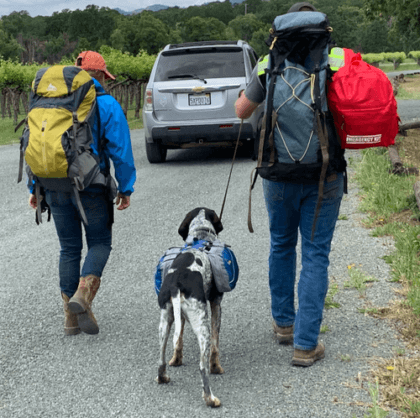Fire season: 10 tips to prep for animal evacuation

The value of early Red Flag and Severe Storm warnings is enormous, says Julie Atwood, the Glen Ellen rancher who founded the Horse and Livestock Team Emergency Response Project in 2013. HALTER has trained first responders on the rescue of animals — Animal Technical Rescue is a now a firefighter certification skill, and the nonprofit maintains Community Preparedness Outreach for people with animals.
This prep-list is one of many resources on the HALTER website. The key, Atwood says, is to have everything in place “before conditions are dangerous and the challenges overwhelming.”
This year, the advent of COVID adds another layer of complications. “A good Disaster Action Plan goal is always to avoid emergency shelters as much as possible, and, during COVID, this is especially true,” Atwood says. “The need for advance planning is greater than ever, and having multiple plans will be stress-reducing, and possibly, life-saving.
1. Start by staying informed
· Keep your weather radios charged and your car radio tuned to local news.
· Make sure you’re signed up for all your local emergency alerts, including alerts for your Evacuation destination(s).
· Follow local Fire, Sheriff and other official resources on social media, especially Twitter.
2. Know where you’re going before Evac Warnings and Orders are issued
· Emergency Managers will be providing Evacuation Maps with “Temporary Evacuation Points”, (TEPs).
· If you have no other resources, find out where animal shelters are caring for evacuated pets, and where to take large animals.
· You and your neighbors can plan ahead to meet up at a TEP or “Rally Point”, and share resources.
· Make a neighborhoodAnimal Safety Shed stocked with supplies – a super resource.
3. Be Resource-Rich
· Line up several destinations where you and your animals can ride out the emergency.
· Arrange emergency transportation resources if you might need them.
· Keep all your emergency information and contacts in several places, including notebooks in your car, purse, and Go-Bags.
4. Update Ready-Kits for COVID
· Update ALL your GO-Bags- for people and animals – to include hygiene and sanitizing items.
· For people: You need extra masks, sanitizer, wipes, liquid soap, disinfectant cleaner, paper towels, toilet paper, and water.
· For Pets: grooming supplies, pet-safe cleaner for carriers. NEVER use household disinfectants or bleach on or near pets! Lots of poop bags, pee pads, and water.
5. Plan for pet comfort and safety
· At Evacuation Centers and TEPs, you may not be allowed out of your car. Have supplies to keep them comfortable and safely contained in the car.
· Plan to take them to animal shelter ASAP
· You may be staying in a motel, campground or apartment complex where your pets will need crates, kennel cages, litter & litter box, pee pads.
· While Animal Care resources will work hard to have mobile units providing temporary boarding and supplies to emergency shelter locations, they may take longer to get there.Pack enough supplies for the first 48-72 hours.
6. Be prepared to care for your animals and keep them secure
· Take enough pet food for3-5 days, pet medications, harnesses, leashes, toys, bedding, cooling pads.
· When possible, arrange for friends or relatives in a safe location to store supplies they can bring to you if you’re in a motel or VRBO. This saves car space!
7. Keep the family together
· You may have to go through a drive-up COVID screen before entering a shelter or evacuation center.Your pets could get out of their temporary home, and will be in unfamiliar territory.
· Make sure your pets are secured in the car. Anxious pets may jump through an open window.
· While evacuated, keep pets in the most secure place possible. Put a “Pet Inside” sign on the door.
· Get pets microchipped now. Make sure their chip info is current.
Have ID on everyone.
8. Planning ahead will help you stay calmer, which will help both you and your animals stay safe and healthier
· Ask your veterinarian about calming meds to have on hand for your pets.
9. If you have equines or livestock, be prepared to observe strict COVID safety at Emergency Large AnimalShelters
· To minimize COVID risks,Staff at Emergency Shelters may be limited. Help our Animal Response resources!
· Follow instructions and arrive prepared to care for your animals while following safe distancing and hygiene procedures, including wearing face coverings.
· Try to have everything you need for at least the first 48-72 hours, such as: Feed, your own hose and buckets, grooming supplies, muck-out equipment, medications, first-aid kit, ID and stall cards.
10. Know How to Request Help
· Don’t wait! If you need help, call your local Animal Care and Control agency, or, the “EmergencyHotline” or “Warm line” number posted by Sheriff, Fire Agency, or local Office of Emergency Services, (OES).
· Resources can respond faster and more safely BEFORE Evacuation Orders are issued, but if your animals are sheltered in place inside an Evac area, request a “Welfare Check”from authorized agency responders.
· Don’t post a call for help on Facebook- that puts responders and animals at risk.
There’s no way to sugar-coat this: these are challenging times. We are our own best resources. We can do this – working together. Reach out to neighbors, your riding club or dog-walking group. Find out which members of your book club have pets! If you can be a resource, contact your local animal shelter orHumane Society, or COPE group or CART (Community Animal Response Team).



